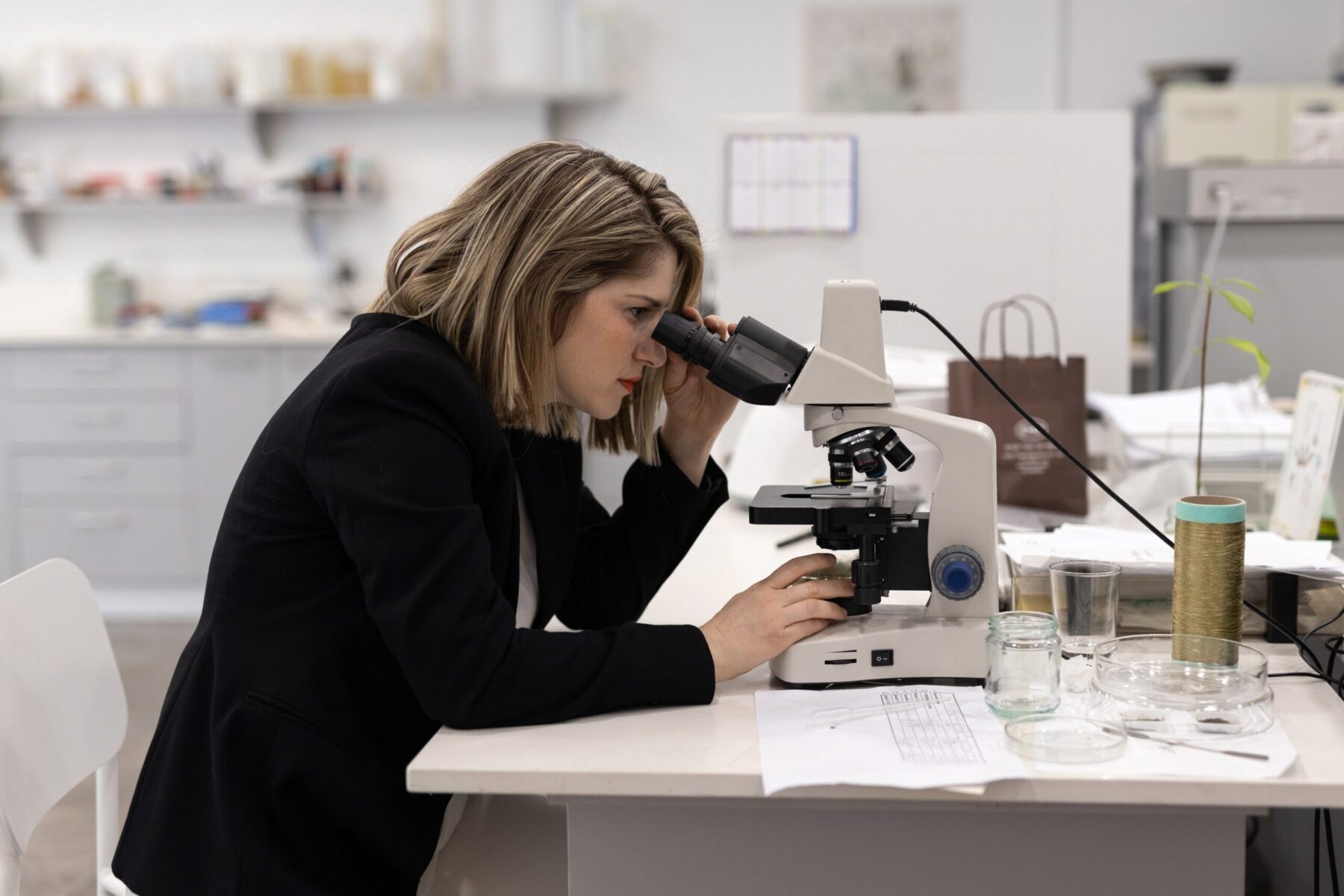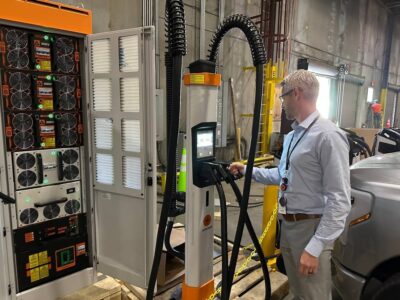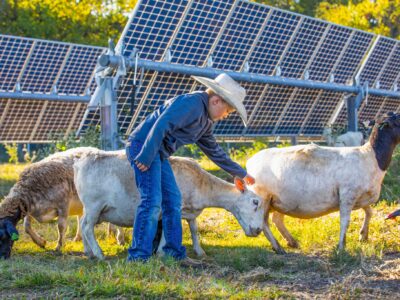(Bloomberg) —
Nutritious and fast-growing, algae already has a following as an alternative protein among health fanatics. A new generation of sustainable fashion startups want us to wear it too.
The fashion industry produces more than 100 billion garments annually, about 14 for every person on Earth. Most end up in landfills or clogging rivers and beaches in developing countries. Only a fraction are ever recycled. Fashion is responsible for up to 10% of humanity’s emissions of planet-warming carbon dioxide, more than international air travel and shipping combined.
For Charlotte McCurdy, a researcher, designer and assistant professor at Arizona State University, tackling the problem means thinking not just about where castoffs end up, but about how clothes are made. Synthetic textiles like polyester, the cheapest and most disposable of all, are made from fossil fuels. The dyes used to imbue fabrics with that inky black? They’re derived from crude oil.
So in 2018, McCurdy set about designing a raincoat made from marine macroalgae, a.k.a. seaweed, which absorbs carbon instead. The choice of garment was a deliberate comment on what we wear to protect ourselves against a climate that’s going haywire because of human activity.
The translucent mac went on display in New York’s Cooper Hewitt Smithsonian Design Museum in 2019. McCurdy also teamed up with New York-based fashion designer Phillip Lim on a dress covered in green sequins fabricated from the same material.
“What I’m trying to emphasize is it doesn’t just matter where they go but where they come from — 60% of clothes are fossil fuels,” she says. “So I did tons of experiments and pulled together tons of technologies and had hundreds of beautiful failures before I was able to create this clear, very consistent plastic that is entirely free of synthetics and chemicals and is made only of algae.”
McCurdy isn’t commercializing her creations; her prime motivation is to show that, with some imagination, it’s possible to do for fashion what electrification is doing for automobiles.
From hemp to fungus, eucalyptus to bamboo, a growing number of startups are looking to nature for just those kinds of solutions. And they’re getting noticed by global retailers like Sweden’s Hennes & Mauritz AB (H&M), which wants to make all its products from recycled or sustainably sourced materials by 2030.
Already used in biofuels and bioplastics, it’s attracting particular attention because it’s fast and cheap to grow, doesn’t need much water and sucks carbon dioxide from the air. Photosynthesizing aquatic organisms produce about 70% of the oxygen in our atmosphere, more than all forests combined. That means algae is not just less bad for the climate, it’s potentially positive.
Renana Krebs founded Algaeing in 2016, two years after quitting a career in fashion. Working with her father, a biofuels engineer, Krebs developed an algae-based alternative to the chemical and petroleum-based dyes ubiquitous in the clothing industry.
After a slow start, interest in Algaeing’s dyes and inks exploded last year. The Israeli startup is now working around the clock to fill the first commercial orders from makers of loungewear, sportswear and home textiles. It’s also developing algae-based yarn, which it expects to begin manufacturing commercially next year. Krebs declined to name her customers but says they include global consumer brands.
“When we started in 2016 this was something that was ‘nice to have,’ but now we have demand and a long waiting list,” says Krebs. “They literally say ‘give us whatever you have.’”
The surge in demand is driven by economic realities. Younger consumers are more environmentally-aware than ever and that’s changing spending habits. The secondhand clothing market is now growing faster globally than the overall apparel market. And the rise of ESG investing is putting pressure on manufacturers and retailers to clean up their acts.
Algaeing has raised about $5 million from investors so far. Krebs is aiming to secure $15 million in another funding round early next year to scale up. The idea is to sell a range of dyes, inks and yarn compatible with existing manufacturing equipment.
“Our partners don’t have to change their machinery, but in the end they’re not harming the environment,” says Krebs. “They use less water, less energy, less transportation and even less lead time. It takes about 180 days to grow cotton; algae takes only three weeks.”
Algaeing’s algae is grown vertically in a closed loop, solar-powered system in southern Israel on land that can’t be used for conventional agriculture. It requires 80% less water than cotton, and no pesticides, to grow. And it avoids the chemicals used to process wool or make commercial dyes.
For context, the United Nations Environment Program says it takes around 2,000 gallons of water to make one pair of jeans. Textile dyeing alone is the second biggest polluter of water globally. And in contrast with polyester, which doesn’t decompose and ends up in the food chain as microplastics, Algaeing’s products are biodegradable and non-toxic.
Ofer Gomeh, CEO of Capital Nature, a Tel Aviv-based venture capital fund that’s invested in Algaeing, says his motivation is purely economic: “Sustainable clothing will be a growing sector.”
British startup Vollebak is all about designing clothes for a more sustainable future. Started in 2015 by twin brothers who are both extreme runners and creative designers, it sells t-shirts woven from hemp and colored with algae that can eventually be tossed on the household compost heap or buried in the garden, decomposing within weeks.
Vollebak has experimented with materials including ceramic particles and the carbon fiber found in jet engines to come up with its range of high-performance adventure wear for a more extreme climate. Among its investors, it counts Airbnb co-founder Joe Gebbia and Sean Brecker, the chief financial officer of Headspace Health.
“Other industries are always creating the future of this and that, but I don’t think anyone else is building the future of clothing,” says co-founder and CEO Steve Tidball. “We look at what is the least amount of energy you can use at the beginning of the process and, at the end, the least amount of energy needed to get rid of it.”
The biggest challenge for algae fashions isn’t practicality, quality or even feel; it’s cost.
Making the hemp and algae t-shirt costs about $110, says Tidball. Vollebak has deliberately sold to celebrities to help spread the word and there’s that growing segment of consumers who’ll spend more on sustainable clothes. But it’s still “too expensive” for the mass market, he says.
McCurdy’s not as worried about cost. Synthetic fibers are artificially cheap because they’re a co-product of oil, which is abundant and used in everything from plastic to power, she says. That advantage will dissipate as the world transitions to cleaner energy.
And any new technology — think solar panels, biodegradable cups, electric cars — is expensive until it reaches scale. The trick is to build that demand.
For McCurdy, that means making sustainable fashions desirable, not just ethical. That’s the point of her one-off statement pieces and it’s what Vollebak is trying to achieve with its focus on futuristic apparel.
“Part of my vision would be something like the Tesla model in design,” says McCurdy. “Making people want the more sustainable thing — even if it is for the wrong reason.”
(Updates to add pictures)
To contact the author of this story:
Gwen Ackerman in Jerusalem at gackerman@bloomberg.net
© 2023 Bloomberg L.P.





